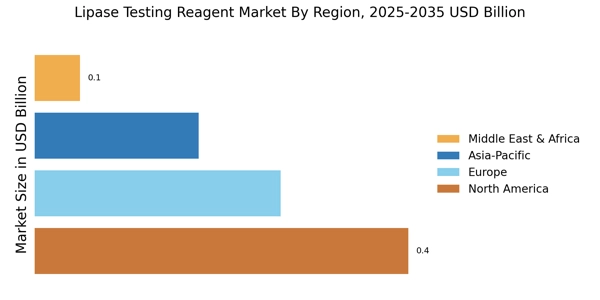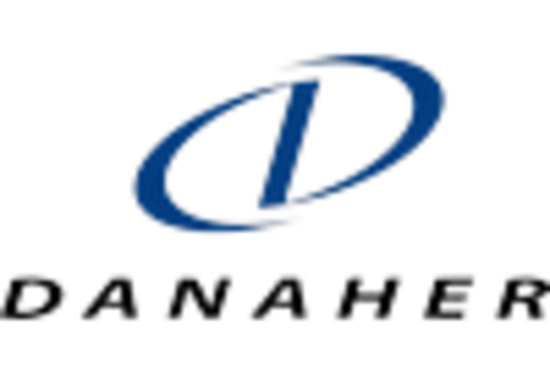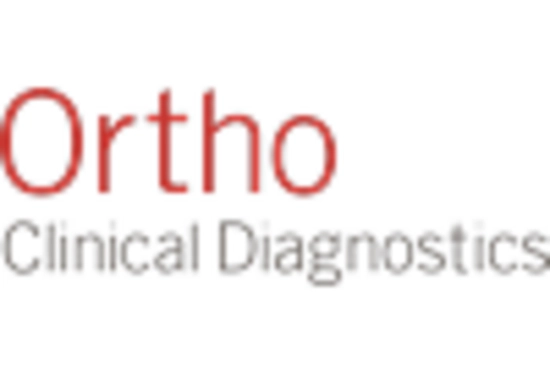Growing Demand for Point-of-Care Testing
The Lipase Testing Reagent Market is witnessing a growing demand for point-of-care (POC) testing solutions. The shift towards decentralized healthcare delivery models is prompting healthcare providers to seek rapid and reliable testing options that can be performed outside traditional laboratory settings. POC testing for lipase levels allows for immediate clinical decision-making, which is particularly beneficial in emergency situations. Market analysis indicates that the POC testing segment is expected to grow significantly, with projections suggesting a CAGR of around 8% over the next five years. This trend is driven by the increasing need for timely diagnostics in acute care settings, where delays can adversely affect patient outcomes. As manufacturers develop more sophisticated POC testing reagents, the lipase testing market is likely to expand, catering to the evolving needs of healthcare systems.
Regulatory Support for Diagnostic Testing
The Lipase Testing Reagent Market benefits from robust regulatory support aimed at enhancing diagnostic testing standards. Regulatory bodies are increasingly recognizing the importance of accurate and timely diagnostics in managing health conditions, particularly those related to pancreatic function. Initiatives to streamline the approval process for new testing reagents and technologies are being implemented, which may lead to a more diverse range of products entering the market. This regulatory environment encourages innovation and competition among manufacturers, potentially resulting in improved testing options for healthcare providers. Furthermore, as regulations evolve to accommodate advancements in technology, the market for lipase testing reagents is likely to expand, providing clinicians with better tools for patient care. The emphasis on quality assurance and compliance will also enhance the credibility of lipase testing, fostering greater trust among healthcare professionals.
Technological Innovations in Lipase Testing
The Lipase Testing Reagent Market is experiencing a surge in technological innovations that enhance diagnostic accuracy and efficiency. Advanced methodologies, such as enzyme-linked immunosorbent assays (ELISA) and high-performance liquid chromatography (HPLC), are being integrated into testing protocols. These innovations not only improve the sensitivity and specificity of lipase tests but also reduce turnaround times, thereby facilitating quicker clinical decisions. The market is projected to grow at a compound annual growth rate (CAGR) of approximately 6% over the next five years, driven by these advancements. Furthermore, the incorporation of automation in laboratories is likely to streamline workflows, making lipase testing more accessible and reliable. As healthcare providers increasingly adopt these technologies, the demand for lipase testing reagents is expected to rise, reflecting a broader trend towards precision medicine.
Increasing Prevalence of Metabolic Disorders
The Lipase Testing Reagent Market is significantly influenced by the rising prevalence of metabolic disorders, particularly those affecting pancreatic function. Conditions such as pancreatitis and diabetes are becoming more common, necessitating regular monitoring of lipase levels. According to recent health statistics, the incidence of acute pancreatitis has been on the rise, with estimates suggesting that it affects approximately 34 individuals per 100,000 each year. This growing patient population creates a heightened demand for reliable lipase testing reagents, as timely diagnosis is crucial for effective management. Additionally, the increasing awareness of metabolic health among the general population is likely to drive more individuals to seek diagnostic testing, further propelling the market. As healthcare systems adapt to these trends, the lipase testing reagent market is poised for substantial growth.
Rising Investment in Healthcare Infrastructure
The Lipase Testing Reagent Market is positively impacted by rising investments in healthcare infrastructure across various regions. Governments and private entities are increasingly allocating funds to enhance laboratory capabilities and expand diagnostic services. This investment trend is particularly evident in emerging markets, where healthcare systems are undergoing significant upgrades to meet growing demand. Enhanced laboratory infrastructure facilitates the adoption of advanced lipase testing technologies, thereby improving diagnostic accuracy and efficiency. Furthermore, as healthcare facilities expand their service offerings, the need for reliable lipase testing reagents is expected to increase. Market forecasts suggest that this investment-driven growth will contribute to a more competitive landscape, with new players entering the market and existing companies innovating to meet the evolving needs of healthcare providers.


















Leave a Comment